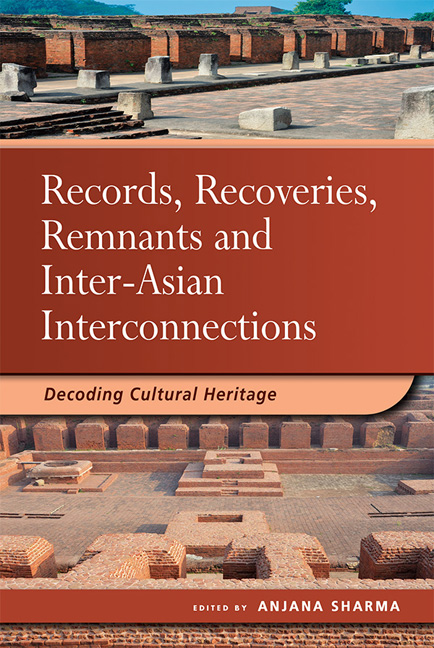Book contents
- Frontmatter
- Dedication
- Contents
- Contributors
- Acknowledgements
- 1 Introduction: Records, Recoveries, Remnants and Inter-Asian Interconnections — Decoding Cultural Heritage
- 2 Negotiating Place and Heritage: Creating Nalanda University
- 3 India, Magadha, Nalanda: Ecology and a Premodern World System
- 4 Collecting the Region: Configuring Bihar in the Space of Museums
- 5 Heritage Preservation in the Gaya Region
- 6 Setting the “Records” Straight: Textual Sources on Nālandā and Their Historical Value
- 7 “Central India Is What Is Called the Middle Kingdom”
- 8 The Object | The Tree: Emissaries of Buddhist Ground
- 9 Tracing Transregional Networks and Connections Across the Indic Manuscript Cultures of Nusantara (AD 1400–1600)
- 10 Seeking a Sufi Heritage in the Deccan
- 11 Archaeological Remains at Nalanda: A Spatial Comparison of Nineteenth Century Observations and the Protected World Heritage Site
- 12 A Heritage Gem Sits in the Heart of a City, Unacknowledged, Incognito: The Case for Recognizing Kolkata Chinatown as a Historic Urban Landscape
- Index
- Miscellaneous Endmatter
2 - Negotiating Place and Heritage: Creating Nalanda University
Published online by Cambridge University Press: 04 July 2018
- Frontmatter
- Dedication
- Contents
- Contributors
- Acknowledgements
- 1 Introduction: Records, Recoveries, Remnants and Inter-Asian Interconnections — Decoding Cultural Heritage
- 2 Negotiating Place and Heritage: Creating Nalanda University
- 3 India, Magadha, Nalanda: Ecology and a Premodern World System
- 4 Collecting the Region: Configuring Bihar in the Space of Museums
- 5 Heritage Preservation in the Gaya Region
- 6 Setting the “Records” Straight: Textual Sources on Nālandā and Their Historical Value
- 7 “Central India Is What Is Called the Middle Kingdom”
- 8 The Object | The Tree: Emissaries of Buddhist Ground
- 9 Tracing Transregional Networks and Connections Across the Indic Manuscript Cultures of Nusantara (AD 1400–1600)
- 10 Seeking a Sufi Heritage in the Deccan
- 11 Archaeological Remains at Nalanda: A Spatial Comparison of Nineteenth Century Observations and the Protected World Heritage Site
- 12 A Heritage Gem Sits in the Heart of a City, Unacknowledged, Incognito: The Case for Recognizing Kolkata Chinatown as a Historic Urban Landscape
- Index
- Miscellaneous Endmatter
Summary
Does place matter? Does it matter in all instances? When locating new institutions does place matter beyond conventional issues of logistics, or will institutions achieve the same outcome irrespective of locale? These are some of the questions that emerged when two places with seemingly long histories and identities seemed to come together in the (re)creation of a new Nalanda university for the twenty-first century. These two places were of course the original Nalanda university or Mahavihara, the archaeological remains of which still exist as testimony to the greatness of what it symbolized, and the settlement of Rajgir, inhabited since prehistory, where the new international Nalanda university was to be located.
The identification with and choice of Nalanda was of course deliberate: Old Nalanda was the inspiration for the establishment of the new university. Old Nalanda, as we well know was one of the flourishing citadels of intellectual pursuit in the world way before organized transmission of knowledge became codified in formal university structures, and it symbolized academic rigour of the highest distinction. Added to this was the evocative symbolism of an interconnected Asia and the journey to Nalanda undertaken by Asian scholars seeking knowledge and learning they could carry back to their regions. It was this voyage that inspired George Yeo, the then Foreign Minister of Singapore, to forward the Nalanda proposal to the Government of India sometime in early 2006. He envisaged a new Nalanda university could once again be
an icon of the Asian renaissance in the 21st century and should draw students and scholars from everywhere, as it once did. It should be a centre of civilizational dialogue and inter-faith understanding, as it once was. It should again make available for the common betterment of all human beings knowledge already existing in the world (Yeo 2011).
Later that year, in March 2006, while visiting Bihar, the then President of India, Dr APJ Abdul Kalam said how impressed he was to learn during a state visit of Singapore's commitment to the project. And it was only because it involved re-establishing a Nalanda for our times, that Amartya Sen agreed to chair the Mentor Group that would guide the project. Enthused by the idea, the State Government of Bihar, decided proactively to explore the setting up of a new Nalanda university.
- Type
- Chapter
- Information
- Records, Recoveries, Remnants and Inter-Asian InterconnectionsDecoding Cultural Heritage, pp. 32 - 50Publisher: ISEAS–Yusof Ishak InstitutePrint publication year: 2018



